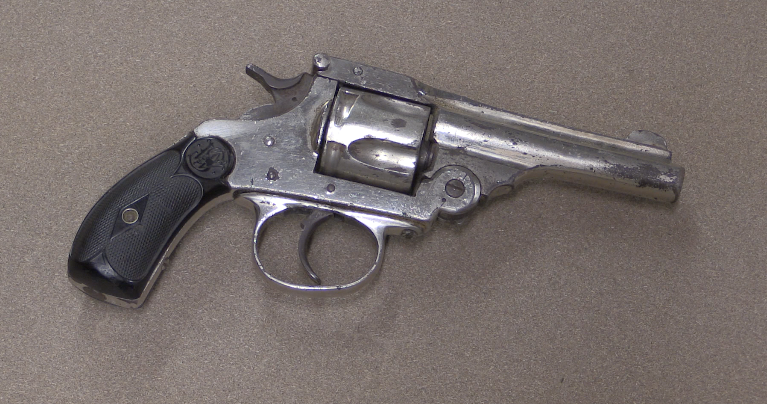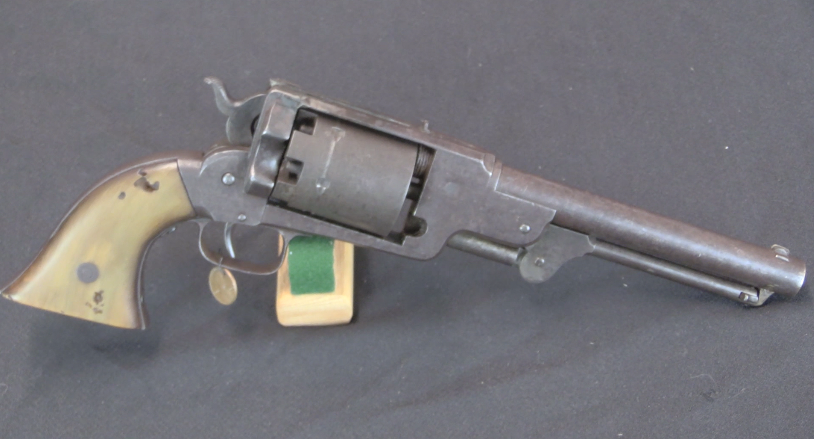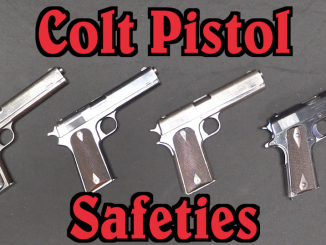The carbine in this video is selling at auction here.
Designed by Gerry Fox in the early 1970s, this carbine saw production sequentially as the Fox Carbine, the TAC-1, and the XF-7 Wasp, as it went through several different manufacturers. It is an open bolt, semiauto carbine sold in both 9mm Parabellum and .45 ACP – and you could get caliber conversion kits consisting of a bolt and barrel assembly to swap caliber on an existing gun. In 9mm they used Sten magazines, and in .45 then used M3 Grease Gun magazines.
The gun was marketed to law enforcement audiences as well as civilians, but never found any LEO success. A fully automatic version was also made, but similarly saw little popularity (because of the cost of NFA registration in the 1970s and 80s). Mechanically, the gun is somewhat akin to the Soviet PPSh, which an upper cover that hinges open and a bolt which is square on the bottom and rounded on top. The TAC-1 version had a few neat additional features, namely a combination lock built into the receiver and a battery in the fixed wooden stock to power a stun gun/baton device for police use. The Wasp replaced the wooden furniture with a fairly clever collapsing metal stock. In total, about 3,500 Fox carbines of all types were made, with production ending in 1983 when the ATF determined that open-bolt semiauto designer were too readily convertible into machine guns.
For much more information on these guns, I suggest having a look at FoxCarbine.net.




“Fox Carbine”
There exist website, which concentrate on that weapon: http://www.foxcarbine.com/
Patent: http://www.foxcarbine.com/images/US3735519.pdf
“Mechanically, the gun is somewhat akin to the Soviet PPSh, which an upper cover that hinges open and a bolt which is square on the bottom and rounded on top.”
As site I linked says:
PPSH41 was Gerry’s [nickname of designer of Fox carbine] favorite sub gun of WWII
While internal similarity is apparent, externally they differ substantially, in my opinion Fox carbine is close in external appearance to Labora sub-machine gun:
https://modernfirearms.net/en/submachine-guns/spain-submachine-guns/labora-eng/
as both have pistol grip (Labora’s is more aft) and lacks barrel shroud, which PPSh and other Soviet sub-machine guns of that era have.
“XF-7 Wasp”
I am wondering why they decide to use such designation/name? It seems to imitate USAAC designation of experimental, photo-reconnaissance aeroplane (cf. XF-12 Rainbow), although I doubt if majority of potential clients in 1970s were aware about that.
I’m guessing “eXperimental Firearm no. 7”, but that’s just a guess. The experiment of course was whether or not BATFET would allow it due to the open bolt system. In the end, they didn’t.
cheers
eon
Drawing on it clearly indicates that it is named after flying insect, however it might be also after U.S. Navy ship CV-7: https://en.wikipedia.org/wiki/USS_Wasp_(CV-7)
However, I am not sure what was awareness of story of CV-7 in 1970s? Was it forgotten by most or despite many years still commonly remembered?
It is not a remembered ship. Nobody knows about the Wasp.
It is not a well known history.
To be fair to the bureaucrats, open bolt weapons can be more prone to accidental spraying if dropped to the ground on “fire mode.” How many times has some idiot thrown or dropped a gun on concrete and had it discharge into a victim’s posterior?
Today its very common with striker fired pistols,stupid users (often cops) uncocking a poor always tensioned striker (by pulling a trigger ofc) and forgetting there is a round in a chamber.
X probably sounds cool, remember the same era
XC 220, 450, 900 ?
“gun was marketed to law enforcement audiences”
There I have question regarding sub-machine gun created for same audience, however created earlier: namely ARCO Abider:
http://augfc.tumblr.com/post/104787159200/arco-abider-in-1953-jack-p-richardson-of-the
created in 1950s, at first look it look as typical sub-machine gun of that era, however it use peculiar feed system, which if I understand correctly, works on endless belt principle and is akin to earlier Sosso automatic pistol
https://modernfirearms.net/en/handguns/handguns-en/italy-semi-automatic-pistols/sosso-eng/
I am wondering about how heavy and fat was magazine for it, as well technical data (barrel length, rate-of-fire, mass of weapon less magazine e.t.c.), only data I found is that it was chambered for .45 Auto cartridge and capacity was 60, description says way to reload was to replace belt with empty cases (spent cases were not ejected) with fresh belt, does this mean magazine body was all the time attached to gun? How was user supposed to carry additional cartridge (stick magazines are just rigid boxes and belt must be flexible)?
The real question is how it achieved automaticity. The cartridge cases were retained, as in a revolver cylinder, so recoil or blowback action is out. The most likely system would be gas operation, but there doesn’t seem to be a gas tube or piston assembly.
In fact, it would seem to be able to operate by some sort of windup clockwork type system, rather like the guns described in The Difference Engine by William Gibson and Bruce Sterling;
https://en.wikipedia.org/wiki/The_Difference_Engine
cheers
eon
” cartridge cases were retained, as in a revolver cylinder, so recoil or blowback action is out.”
So every pocket in that endless belt is chamber, like in Treeby Chain Gun
https://www.forgottenweapons.com/rifles/treeby-chain-gun/
?
At first glance I assumed it worked like Breda Modello 1937, that it bring cartridge from feed device, rammed it into chamber, fired, bring case and insert it in said feed device, however if it work like Treeby, then 60-round belt must be incredibly heavy when compared to normal magazines
I got a vaguely related question :
Are there some basic mathematics formulas to evaluate (more or less) the ideal barrel length for a given ammunition? And how much performance will increase or suffer?
In case of US long barrel semi-auto carbines law, is there a niche market for optimized ammo? (I remember some article about Uzi dedicated 9mm that was replicating .357 characteristics)
“ideal barrel length for a given ammunition”
But was it ideal barrel length in your view?
Length of barrel which will give maximal muzzle velocity?
Length which give most fps per inch of barrel?
Length for which flash signature is smallest?
Length which give smallest spread?
There is report for experiment regarding muzzle velocity vs barrel length for 7,62×54 R cartridge: http://honors.usf.edu/documents/thesis/u82488180.pdf
See illustration at page 23, for table barrel length vs muzzle velocity.
I was thinking about a barrel that could combine full powder combustion with accuracy. Would it cost velocity?
(In that case, I am not taking in account heavier or more aerodynamics projectile for accuracy)
“full powder combustion”
What you probably wants to achieve is to make such weapon where pressure of gases would drop to 0 exactly at muzzle, however due to varying parameters (even of same propulsive powder) it is hard to obtain in reality, so you might get situation where pressure will be depleted before bullet reach muzzle velocity, which is undesirable as bullet will now slow down (due to friction between it and barrel), so it is better to have some margin, that its still some pressure at muzzle.
–
Regarding muzzle velocity vs barrel length, what you probably needs is so-called pressure curve, example of such curve can be seen here:
http://closefocusresearch.com/calculating-barrel-pressure-and-projectile-velocity-gun-systems
If you have one, muzzle velocity might be estimated by integrating.
is: “(…)reach muzzle velocity(…)”
should be: “(…)reach muzzle(…)”
“Are there some basic mathematics formulas to evaluate (more or less) the ideal barrel length for a given ammunition? And how much performance will increase or suffer?”
I am not sure about sub-machine gun, however for artillery system you might useful
Engineering design handbook AMCP 706-150 Ballistic Series Interior ballistics of guns
Thanks for the manual !
“Uzi dedicated 9mm that was replicating .357 characteristics”
Hotter loading for sub-machine guns are nothing new, there were intended to enhance range, however it must be noted that it was often possible thanks to sub-machine gun being stronger and such ammunition might be dangerous when used in automatic pistol.
One example is Patchett machine carbine: https://modernfirearms.net/en/submachine-guns/great-britain-submachine-guns/sterling-l2-l34-eng/
If you look at old law enforcement gun publications circa 1980, S&W was trying hard to find buyers for the Carl Gustav clones they had tooled up for during Vietnam.
If S&W was having a hard time selling 9mm open bolt SMG guns, of a proven design, to law enforcement, it should be of no surprise that a start up company, with an untested design, would have no luck either.
Speaking as someone who was on the receiving end of the “please buy our swell stuff” entreaties at the time, there were three factors all the would-be SMG marketers overlooked.
First, military and law enforcement requirements for an SMG are fundamentally different. In the military, volume of fire at close range is paramount; a soldier wants to blanket an area with slugs to cripple or kill anybody in it, because anybody there is defined as The Enemy.
In law enforcement, we rarely have that situation. Usually, when we have multiple suspects in a relatively confined space, it’s at least potentially a hostage situation. Meaning, we’re only supposed to shoot the “bad guys”.
The classic case is a bank robbery gone bad, with multiple armed suspects inside with customers, tellers, etc. as “human shields”. An open-bolt, API SMG is about the last weapon I’d want in that kind of situation; the chances of hitting somebody I didn’t want to would be too high. Even the traditional (for American LEO) M1 .30 carbine might be too much due to overpenetration, unless loaded with something like Glaser Safety Slugs (Yes, they were made in .30 USC).
Believe it or not, the optimum choice for that sort of situation would be the standard .38 or .357 revolver, loaded with hollowpoints or Glasers. Easily and quickly maneuverable in tight quarters, difficult for the suspect to grab, and with the correct ammunition a good man-killer. Most importantly, accurate enough even in fast double-action fire to place a bullet exactly on target, even if the target is holding someone in front of them and you have to go for a head shot.
Secondly, there was the image problem. The “militarization of the police” issue was common fodder for the press even then, and departments that displayed obvious military-grade small-arms could expect a s**tstorm of bad press from anybody and everybody with an outlet and a grudge against the “pigs”. Which was most of the news media, then as now. It was simply not a good time to have anything that didn’t look “conventional” or “civilian”, a factor that kept self-loading pistols generally and 1911A1 type pistols in particular out of police holsters for over two decades.
NB: I once saw a reporter nearly faint when she saw a firing range in use with sheriff’s deputies using .357 revolvers and a few S&W 9mm and Colt .45 automatics. It wasn’t the powerful Magnum revolvers she was freaked out by, because “cops” carried revolvers. It was the “military” automatics, never mind that they were actually using less powerful ammunition than the “civilian-type” wheelguns.
For a long time, I carried a Colt Lawman MK III .357 snub for that exact reason; as a “lab guy”, I was seen as a “detective”, and according to Hollywood, detectives carried snub-nosed Colt or S&W “.38″ revolvers. By comparison, my old Colt MK IV Series 70 .45 was cause for smelling salts.
Finally, there was the cost factor. The SMGs were expensive beasts, even with the police discount. This was especially true of about the only practical police SMG, the H&K MP-5, which fires from a closed bolt and is noted for its accuracy on single-shot and in burst fire. Most departments ended up with M1 .30 Carbines because aside from superior accuracy and if needed barrier-defeating capability, we could generally buy two or even three brand-new Plainfield or Iver Johnson-made .30 Carbines for the cost of one MP-5 or other SMG.
Besides, at the ranges we’d be using a high-fire-volume weapon, generally ten yards or less, there was already a weapon in every department’s inventory that filled the bill much better and more economically than any SMG. Namely the 12-gauge police shotgun, 20” barreled rifle-sighted “deer gun” type, improved cylinder bore, loaded with 00 or 000 buckshot. And if we needed no-doubt, right-now, dead-on-the-spot “stopping power”, a 12-gauger rifled slug was about as close to that as you could ever get with an individual weapon. It hit like a Civil War era .58 rifle musket Minie’ ball, but harder due to higher velocity; what would cripple or kill a man at Shiloh or Cold Harbor would do it just as effectively 12 decades later at an attempted liquor store holdup.
For American police work at least, the open-bolt, API SMG in 9 x 19mm or .45 ACP was, to quote Col. Cooper, an ingenious answer to a nonexistent problem.
cheers
eon
“departments that displayed obvious military-grade small-arms could expect a s**tstorm of bad press from anybody and everybody”
This would explain why Reising sub-machine gun was still used in police application longer than in military:
https://modernfirearms.net/en/submachine-guns/u-s-a-submachine-guns/reising-m50-m55-eng/
with it wooden furniture and lack of pistol grip it was much closer look-wise to sporting repeating rifle than other sub-machine guns like say MP5.
“because “cops” carried revolvers”
Indeed true for U.S. back them, but there was not similar pressure in Europe, FN tried in 1970s to introduce revolver, which would find customers both in Europe and USA, namely Barracuda:
https://modernfirearms.net/en/handguns/double-action-revolvers/belgium-double-action-revolvers/fn-barracuda-eng/
As you might deduce from photos it is revolver of conventional construction, with distinctive feature being swappable cylinders allowing usage of .38 Special, .357 Magnum or 9×19 Parabellum cartridge. It never catch bigger interest, with USA having own well-established producers and European users prefer automatic pistol (notice for example that Walther PP stands for Polizeipistole)
Yes, and PPK stands for Polizeipistole Kriminal, because in Germany the police detective bureau was called the Kriminalamt, literally the bureau for investigation of criminals.
Thus, the PP was intended for open carry in a belt holster by a uniformed officer, while the PPK was intended for concealed carry by a plainclothes detective.
In an interesting sidelight, during the Occupation, the U.S. government re-equipped the West Berlin PD and other police units in West Germany with American S&W Model 10 revolvers in .38 Special.
As soon as they could, the majority of those agencies traded in the S&Ws for any automatics they could get, even Eibar-made 7.65mm Browning types from Spain, which were far inferior to the S&Ws. Simply put, the Continental police culture was more comfortable with self-loaders than revolvers.
I always thought the FN revolver would have sold reasonably well here in the U.S. as a civilian sporting arm, simply because its multi-caliber capability would have appealed to the same people who liked the various Ruger single actions with the same feature (.357/.38/9mm, .45 Colt/.45 ACP, .44 Magnum/ .44-40 WCF, etc.).
Of course, under GCA ’68, about the only variant that would have been legal to import would have been the 15cm barreled target-sighted version, and it probably would have ended up selling for a higher price than the equivalent Colt Python.
cheers
eon
Where is the auction link?
If FORGOTTEN WEAPONS was a DRINKING GAME,
every time Ian says “Big ol’ hole”, you would need to drink a double shot of whiskey
😀
A couple of things about this gun that are interesting, but not mentioned in Ian’s video:
1. At the end of the receiver you will find the letters “TH NK” straddling the receiver latch. So, every time you get ready to fire the gun you see “TH1NK”
2. You cannot get to the fire control mechanism without permanently modifying/destroying the gun. Its permanently sealed. I suspect ATF originally approved the design because of this. However, its pretty easy to see how someone could make it full-auto without destroying the gun, and that’s likely what caused ATF to have a change of opinion about this style gun.
3. Lastly, the rotten-cheese buffer MUST be replaced before attempting to fire one of these, otherwise the bolt will crack the aluminum receiver.
Does anyone know where I can find a buffer. I have a 45 carbine but the buffer fell apart